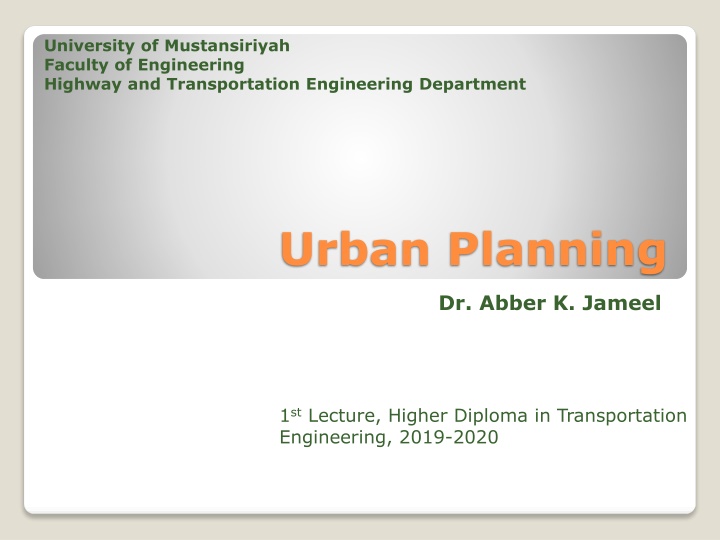
Urban Area Planning and Transportation Engineering Overview
Discover the fundamentals of urban planning and transportation engineering in this comprehensive guide. Learn about urban areas, the importance of planning, the role of urban planners, and the sub-sectors of urban transportation planning. Dive into the world of infrastructure development, land use, and sustainable practices for a better urban environment.
Download Presentation

Please find below an Image/Link to download the presentation.
The content on the website is provided AS IS for your information and personal use only. It may not be sold, licensed, or shared on other websites without obtaining consent from the author. If you encounter any issues during the download, it is possible that the publisher has removed the file from their server.
You are allowed to download the files provided on this website for personal or commercial use, subject to the condition that they are used lawfully. All files are the property of their respective owners.
The content on the website is provided AS IS for your information and personal use only. It may not be sold, licensed, or shared on other websites without obtaining consent from the author.
E N D
Presentation Transcript
University of Mustansiriyah Faculty of Engineering Highway and Transportation Engineering Department Urban Planning Dr. Abber K. Jameel 1st Lecture, Higher Diploma in Transportation Engineering, 2019-2020
Introduction Urban Area refers to cities or Built-up area with high population density, has a population of 5000 or more, and infrastructure of built environment. Urban is the opposite of rural, where farm lands and nature are. Urban areas are usually cities and towns. Most of the work available in urban areas is factory and office work. Urban areas are very developed, meaning there is a density of human structures such as houses, commercial buildings, roads, bridges, and railways. A large urban area, with all connected areas (usually developed around some city) is called a Metropolitan area.
Introduction Planning is making of an orderly sequence of action that will lead to the achievement of a stated goal or goals. Urban Area Planning, traditionally, is a process of guiding the use and development of land through ordering land/land uses and siting buildings and communication routes with the aim of making the city a better place to live and, to secure the maximum level of economy, convenience and beauty. Recently, urban planning has been carrying out as socio- political and economic activity
Introduction In these terms planning: Links knowledge and action: connectedness Improves the humanized and natural environments Focuses on the future Sustainable development to meet the needs of present generations without compromising the ability of future generations to meet their own needs.
Introduction An urban planner is who primarily concerned with the allocation of resources according to projections of future need. Architect, on the other hand, designs buildings. A good architect will do all he can to relate the building he is designing to its surroundings, but he has no control over what happens off the property he has been hired to considered. An Urban Designer, who design the city, not just the buildings.
Introduction Urban Transportation Planning In the urban transportation planning, the following sub- sectors are considered: Different modes of transport; Integration with the environment; Integration with land use planning; Integration with policies for education, health and wealth creation.
Introduction This concept recognises that land use and transportation are interlinked as land use affects and is affected by transportation policy. Consequently, in order to have an efficient and effective transport system, land use must be planned right. Proper urban planning based on right transport access Therefore, the different policy disciplines have to work together to deliver the best results for the functioning of urban areas.
Introduction The aim of the course The aim of this course is to focus on the theories of land use planning as an important part of urban area planning and how this affects the sustainable urban transportation planning
Introduction Practice of the week Search for and choose three references that may meet the aim of this course, and explain why?















